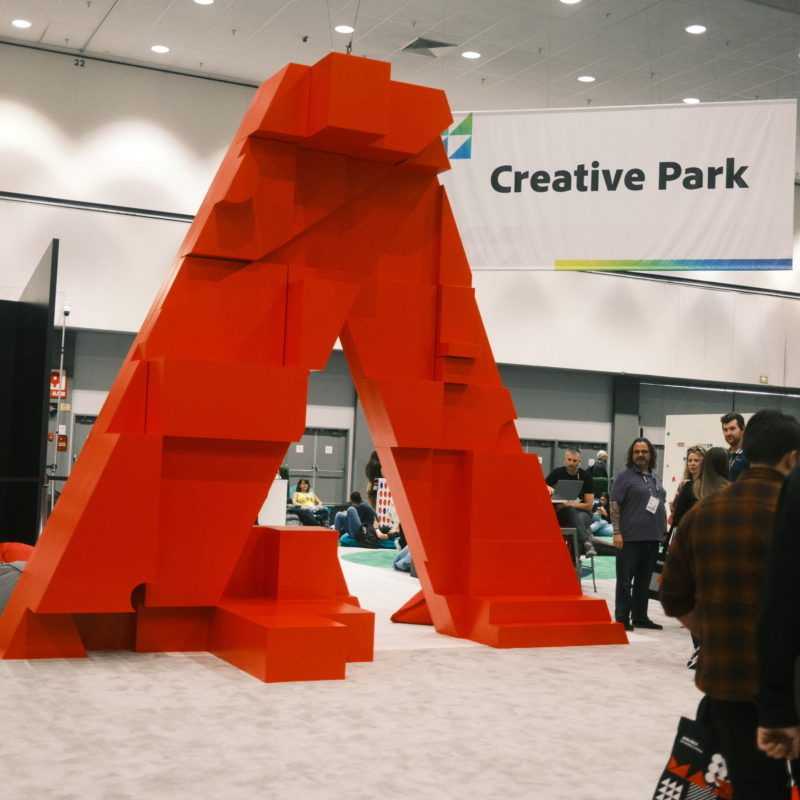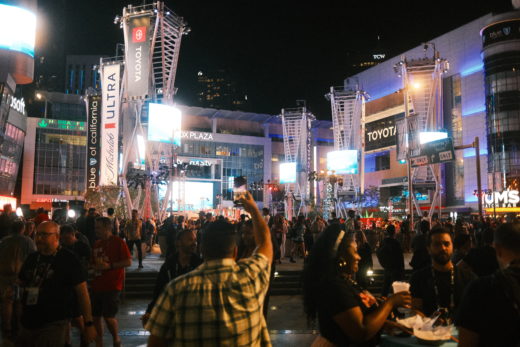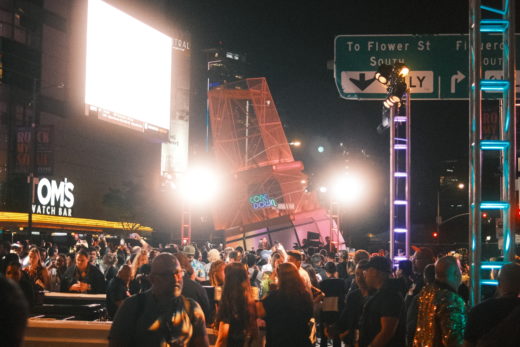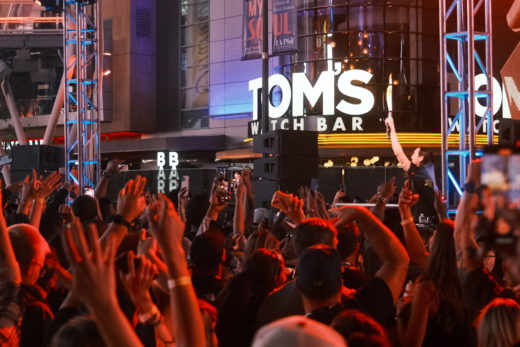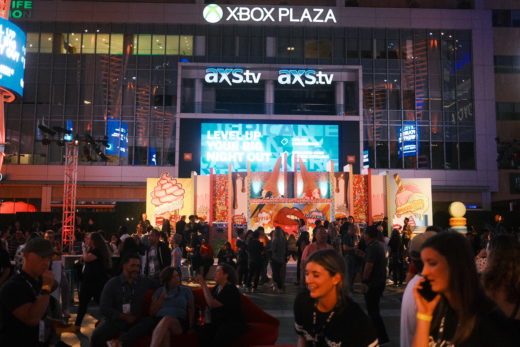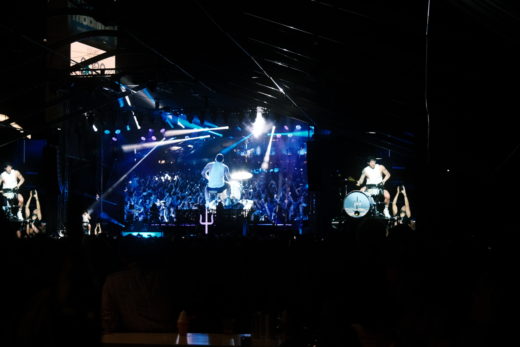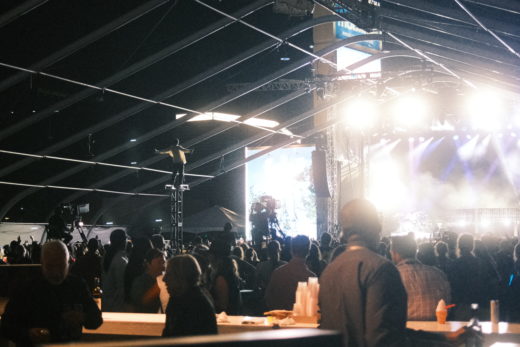Every year, Adobe hosts thousands of people for their fantastic “creativity conference”, Adobe MAX. These like-minded creatives mill about the Los Angeles Convention Center networking, collaborating, celebrating, and educating as they spend the three days at what could almost be described as Creative Summer Camp. On top of all of the classes to learn from and vendors to talk to, there are crafts and snacks and even some games. There’s two big parties (one being the massive “MAX Bash” that takes over the entire LA Live facility including Crypto.com arena, ending in a concert) and a smattering of smaller ones that take place after hours. It truly is unlike any other conference or trade show out there.
During the events of the past couple years, however, this event went fully online. This was actually fantastic as everyone across the globe could attend the sessions, keynotes, and presentations from the comfort of their own home (it can certainly be challenging to hit every session you want in person, if only for the distance you have to run to get there in time between them) but that did mean the networking and creative invigoration one feels by being there in person was somewhat absent.
This year, with Adobe MAX returning as an in-person event (with online sessions still being made available, wonderfully) I set out to interview everyone I could find, both vendor and attendee alike, to attempt to highlight what makes the event so fantastic and give you just a taste of what going to the event in person actually entails. Minus all the, you know… walking and eating and the like. One thing I personally love about being there in person is that I’m able to walk around and kind of absorb other artforms and disciplines by osmosis. While I’m obviously focused on film-related endeavors, there are so many skills and methods that can cross over between disciplines that it’s important to always keep learning even outside of what your career necessitates. Design, for instance, is universal, and if you’re making graphics for your videos you’ll need a solid foundation in it. Color theory. Photography, obviously. There’s just so much to learn, and even the sort of “unrelated” skills WITHIN those skills are useful, like maybe you learn how to better manage clients via a Typography session. Who knows! It’s easier, at least for me, to get roped in to those types of things when I’m walking around it than when I have to pick those things off a virtual menu of sorts. Plus, when you meet new people, they turn you on to cool stuff that would otherwise be in your blind spot. So let’s dive in!
If this kind of coverage is something you’re interested in and would like to see more of, please subscribe to the ProVideo Coalition YouTube channel, and feel free to make suggestions about what else you’d like investigated at next years event or at other conferences in the comments of this article.
The event kicked off with the Opening Keynote, where we heard from the likes of Shantanu Narayen (Chairman and Chief Executive Officer at Adobe), Scott Belsky (Chief Product Officer and Executive Vice President of Creative Cloud at Adobe), and David Wadhwani (President of Digital Media Business at Adobe). They, with the help of many other speakers, demonstrated new and exciting things within the Adobe Creative Cloud suite of tools, as well as what we could look forward to in the future. If you’re here looking for the true Adobe MAX experience, that two hour presentation is here for your enjoyment (the video portion starts around 1:08:00):
During that presentation they talked about Frame.IO and Camera 2 Cloud integration, and I’d like to take the moment to call out that we were using that system the entire time. From start to finish, my camera man Adam and I, backed by our editor Omar, would get videos out almost as fast as we shot them by using Camera 2 Cloud which was a HUGE benefit because A) I personally didn’t have to edit but B) that meant that we were “first to publication”. This was the same system we used at Cine Gear this year with PVC’s own Scott Simmons editing from Nashville while Adam and I were filming in Los Angeles (still at the convention center, this year).
C2C is an amazing system that “just works” and allows you to send proxy files (up to 4K and even original camera negatives in some cases) directly to your editor in near-real time by way of applicable hardware. We were using my Canon C500mkII and a Teradek Cube 655, but nowadays there are systems like the ones from Atomos where the process is camera agnostic. All of this is fantastic for a number of reasons, not least of which being:
1) Your editor can be an extra set of eyes and let you know immediately when something with your footage is wrong whether that be bad audio, missed focus, or otherwise.
2) Your editor is able to get to work sooner, making the Production to Post-Production pipeline a more parallel experience instead of a linear one.
3) You instantly have an off-site backup of your footage (Frame.IO apparently saves your footage 6 times before giving you your clip in Premiere).
4) In cases like ours, the 8Mbps Proxy files coming out of the C500 are perfectly acceptable for YouTube broadcast, so we can use those in place of the full-res camera files.
We talked to Michael Cioni and Morgan Prygrocki about Frame.IO and C2C, in which Michael showed us the new Fujifilm XH2 and RED V-Raptor integrations which allow for that aforementioned OCN transmission, as well as sending photos in the Fujifilm’s case, and Morgan talked to us about some insane new developments in the Virtual Production space:
We also spoke to Adobe’s Senior Director of Premiere Pro Marketing Paul Saccone about the just-released Ver23 of the program, touted as the most stable version of Premiere Pro yet:
And if you had your interest piqued hearing about the camera-agnostic C2C system that Atomos offers, we went and talked to Senior VP of Product at Atamos Paul Scurrell about that (and more) as well:
Adobe MAX has generally been geared towards folks who are illustrators and designers over the years, as those userbases are far larger, but it was nice to see a heaping helping of video stuff this year and we’ll get to some more in a moment. First, though, I wanted to highlight the various Sessions you can check out. Obviously there were in-person Sessions, some of which had “follow-along” components with rooms full of laptops for attendees to use, but the online courses are made available for you even now!
If you navigate to the Adobe MAX Session page you’ll see 178 different presentations you can watch, with groupings at the top so you can focus on, say, video content. It’ll even let you group by skill level or even if you just want inspiration as opposed to education.
One Session I’ll call out is Mark Mann’s “Transitioning from Stills to Video” presentation, as we held a similar event at Filmtools recently with Paolo Cascio that was really well-received. There was also a great Session on Media Asset Management by the folks from Amazon Web Services if that sounds like something you’re in need of diving deeper on.
Adam and I got to sit in on an in-person presentation (not available online) with filmmakers Jonathan Bird and Noah Ramirez of the Oceanic Research Group, and were able to pull them aside to talk about said presentation and dig deeper on the intricacies of Giant Screen Filmmaking (where I kind of went in to Frame & Reference mode) and their wildly successful YouTube channel BlueWorldTV:
There also was some really interesting looking presentations on Color Techniques, Audio Hacks, and Motion Graphics but they’re all in Japanese and I’m unfortunately a bit rusty so I have no idea what they’re saying. For you, however, that might be worth checking out!
Adobe Master Trainer Maxim Jago (what a name by the way) hosted a course on methods to speed up your editing workflow inside Premiere which may be of use to you. I certainly try to pick up tips wherever I can as speed is pretty much everything these days (again why we used C2C for our coverage!)
You may also want to give Marty Buccafusco’s presentation a look, as he’s Coca-Cola’s Video Creative Lead and has some fantastic insights on collaborative work across a global team.
My friend and Adobe Video Trainer/DP/Director Valentina Vee had a great session aimed at newer creators in which she showed some best practices and tips on creating for Social Media and afterwards we had a nice chat about it and more:
Finally, I’d be remiss if I didn’t highlight Vashi Nedomansky, ACE and David Leopold’s presentation “Creativity Connected: The Importance of Agile Workflow” as I’ve learned a lot from Vashi and his insight is always valuable. Vashi’s blog is a great place to glean some tips and tricks from his extensive career as a Hollywood-level editor. He’s got a great post on Perfecting the Film Post Production Workflow as well as a “one page film school” where he collected a ton of BTS and assets from Raiders of the Lost Ark. He has one for David Fincher’s Panic Room too that I’d suggest checking out. He even made the Premiere Template he used on Deadpool available for download, which I use (slightly modified) to this day. Great resources all around!
Like I mentioned earlier, not everything at MAX is video-centric, and one person I personally look towards as a constant source of inspiration is Aaron Draplin. Literally just look up anything about the guy, there’s tons and tons of educational and inspirational stuff that he’s put out over the years, but at MAX he had a session on Gratitude (and a lot more, the man moves fast) that we talked about as well as his 10 years at the conference:
There was also a brief moment where I was pulled into a secret meeting room to talk about Adobe’s new developments in the 3D and AR space via Adobe Substance, which is fascinating and something I deeply wish to learn more about, especially as Virtual Production is more and more becoming a “necessary” skillset for filmmakers and 3D asset management, creation, and ideation are a huge part of that:
As I mentioned, I intended to talk to MAX attendees as well and I was privileged enough to meet some wonderful folks from across the creative spectrum (Photographer & Fujifilm Ambassador Derek Fahsbender, Saab’s Marketing Communications Manager Jörgen Ericsson, and Bay Area Educator Carolyn Moore) and talk to them about their work, where they come from, and what they look forward to when attending Adobe MAX:
Now, in those and previous videos you’ll notice we mention that it’s either the first or second day of the conference. The only thing you missed between Day 1 and Day 2 is the Welcome Reception (which we covered on PVC’s Instagram Stories) where from 6pm to 8:30pm, they wheel out just tons and tons of snacks and beverages (adult and otherwise) to the main conference floor and attendees are able to mingle, chat, and peruse the various vendors we’re highlighting here without needing to immediately jet off to a session. With that being said, why don’t we quickly link you to the second day’s Inspiration Keynote with painter/illustrator Kadir Nelson, musician Steve Aoki, photographer Cristina Mittermeier, filmmaker Siân Heder, and artist Jeff Koons (you know, the balloon dog sculpture guy!).
Among all that action we took the time to walk the floor ourselves and talk to some of the vendors and sponsors who had set up shop at MAX to see what they had to offer. For instance, did you know Avid and Adobe are actually partners?
Or that your Audio workflow is entirely single threaded and cpu-based and may be the culprit if your system seems to be slogging?
How about all the deep coding work (made simple by Effect House) that goes into those TikTok filters?
I even got to check out the newest hottest machines designed for creators from ASUS by way of their “ProArt” line:
There’s even a few people on the floor not there hocking wares but simply giving presentations, talking with attendees, and giving advice like Chris Do of The Futur:
And finally, because it’s the thing we all look forward to that isn’t Bash (no I didn’t film Bash, who wants to watch people go to a party and have fun without them?) we’ve got Sneaks. For those that don’t know, Sneaks is a fun little event right before Bash where everyone gets together, grabs a drink or two, and learns about the cutting-edge stuff on the horizon for their favorite programs from the engineers who create them. These are things that may or may not end up in a final version of, say, Premiere or Illustrator, but are a fascinating look nonetheless at the type of things the people at Adobe are cooking up:
And that pretty much covers it! On the third day we just went back to collect some swag from around the floor and return our Camera 2 Cloud system (thanks to the team at Adobe and Frame.IO for that!). I hope you found this coverage engaging, and if it inspires you to I highly encourage attending the conference in-person next year. Even with all the interviews and Sessions listed here, there’s so much more to experience at MAX and it really comes down to the community. Going to Cinegear or NAB is great; you learn about all the new technologies and fun gear coming out and that’s awesome, but Adobe MAX truly is a “creativity conference”. While it’s got companies, including Adobe, launching new products and services, it’s mostly about getting your juices flowing and meeting like-minded people who can not only teach you things and inspire you but also maybe help you along in your career. I’ve met a couple people at MAX like my good friend Joey Fameli, who I later had on Frame & Reference, who I’ve since worked with and who has thrown a job or two my way. I’ve made friends who aren’t in my field who I still talk to and get excited when I see what new things they’re doing. Hell, one time I ran into my MAX-buddy Blayne (also McMillan, hilariously enough) at a bar in Breckenridge, CO where he was DJing. The excitement we shared (and shouted) when we locked eyes across the dance floor was borderline inappropriate.
All this is to say that one thing conferences don’t tend to facilitate is friendship. There’s a ton of business cards flying around but you don’t really get to just talk about the work or the fun stuff, it’s all business. At least in my experience. You’ll constantly hear how it’s not what you know but who you know in this industry, and Adobe MAX is uniquely the only “who you know” conference with tons of education and inspiration to go along with it, which at its heart is about personal and artistic growth, not ad placements and sales. It’s the only conference like it and it’s absolutely worth attending for all that and more.
Plus there’s a pretty rad party at the end.

Filmtools
Filmmakers go-to destination for pre-production, production & post production equipment!
Shop Now